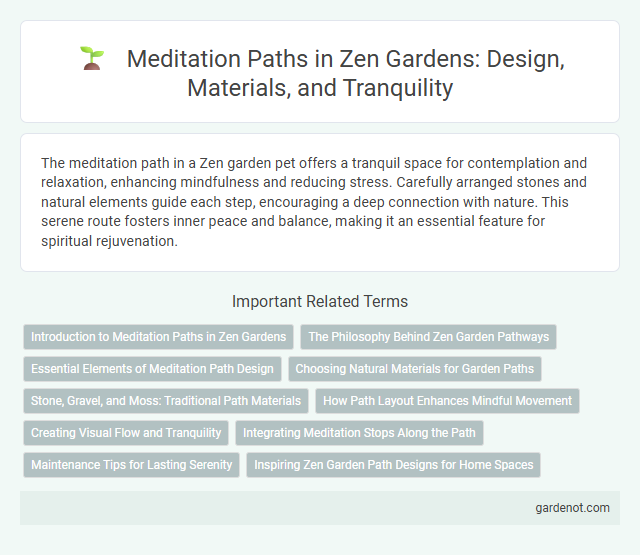The meditation path in a Zen garden pet offers a tranquil space for contemplation and relaxation, enhancing mindfulness and reducing stress. Carefully arranged stones and natural elements guide each step, encouraging a deep connection with nature. This serene route fosters inner peace and balance, making it an essential feature for spiritual rejuvenation.
Introduction to Meditation Paths in Zen Gardens
Meditation paths in Zen gardens are carefully designed walkways that guide practitioners through a tranquil environment, encouraging mindfulness and deep contemplation. These paths often incorporate natural elements like stones, moss, and raked gravel to symbolize the journey toward inner peace and enlightenment. By following the meditation path, individuals can cultivate a focused state of mind, enhancing the overall Zen garden experience.
The Philosophy Behind Zen Garden Pathways
Zen garden pathways embody the philosophy of simplicity and mindfulness, designed to guide practitioners through a meditative journey that encourages present-moment awareness. The deliberate arrangement of stones, gravel, and stepping stones symbolizes life's impermanence and the flow of energy, fostering a tranquil environment that nurtures inner peace. These pathways emphasize intentional movement and contemplation, aligning physical steps with spiritual progress in Zen practice.
Essential Elements of Meditation Path Design
A meditation path in a Zen garden incorporates essential elements such as smooth, flowing lines to guide mindful walking, natural materials like gravel or stepping stones for tactile engagement, and strategically placed plants or sculptures that encourage quiet reflection and focus. Carefully balanced proportions and simplicity prevent distractions and foster a serene atmosphere conducive to deep meditation. Integrating water features or subtle sound elements can further enhance sensory tranquility and promote inner peace.
Choosing Natural Materials for Garden Paths
Selecting natural materials such as gravel, flagstones, or compacted earth enhances the authenticity and tranquility of a Zen garden meditation path. These materials promote a grounded sensory experience, fostering mindfulness and connection with nature. Incorporating bamboo edging or smooth river rocks can further define the path while maintaining organic harmony with the garden's aesthetic.
Stone, Gravel, and Moss: Traditional Path Materials
Stone, gravel, and moss are traditional materials essential to the meditation path in Zen gardens, each symbolizing natural elements that encourage mindfulness. Smooth stones guide contemplative movement, while raked gravel represents flowing water and promotes a tranquil mental state. Moss adds lush greenery, enhancing the garden's serene atmosphere and grounding practitioners in nature's calm presence.
How Path Layout Enhances Mindful Movement
The path layout in a Zen garden is meticulously designed to guide slow, deliberate steps that encourage mindfulness and present-moment awareness. Curved and uneven stone arrangements gently shift attention, promoting a meditative state through physical engagement with the environment. This intentional design supports a rhythm of calm, focused movement that deepens the meditation experience.
Creating Visual Flow and Tranquility
The meditation path in a Zen garden is designed to create visual flow through carefully placed stones and natural elements, guiding the eyes and mind gently along a calming route. This intentional arrangement fosters tranquility by promoting mindfulness and a harmonious connection between the walker and the surrounding environment. Subtle transitions in texture and color enhance the sensory experience, deepening relaxation and focus throughout the meditative journey.
Integrating Meditation Stops Along the Path
Integrating meditation stops along the Zen garden path enhances mindfulness by encouraging periodic reflection and deep breathing exercises. These designated areas often feature natural elements such as smooth stones, bamboo benches, or small water basins to create tranquil settings conducive to meditation. This thoughtful incorporation promotes a rhythmic flow between movement and stillness, deepening the overall meditative experience.
Maintenance Tips for Lasting Serenity
Maintaining a meditation path in a Zen garden requires regular clearing of debris such as leaves and twigs to preserve its tranquil appearance and prevent slips. Frequent raking with a bamboo rake helps sustain the garden's signature patterns, enhancing the meditative experience. Periodic inspection for uneven stones or overgrown moss ensures safe, seamless walking, fostering lasting serenity.
Inspiring Zen Garden Path Designs for Home Spaces
Inspiring Zen garden path designs for home spaces utilize natural materials like smooth river stones, bamboo, and wooden planks to create tranquil walkways that encourage mindfulness and meditation. Curved layouts and subtle changes in elevation enhance the sensory experience, guiding the mind toward relaxation and clarity. Incorporating moss, gravel, and carefully placed lanterns further enriches the serene atmosphere, making each step a deliberate act of peaceful contemplation.
Meditation path Infographic

 gardenot.com
gardenot.com